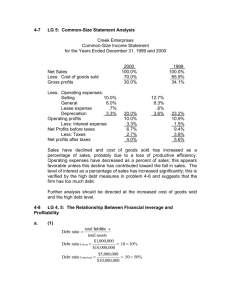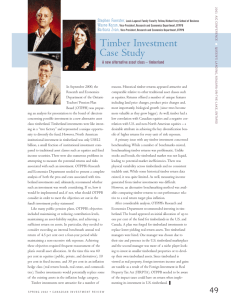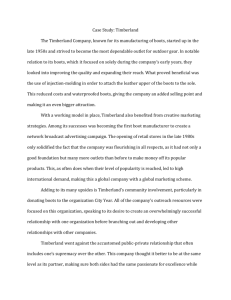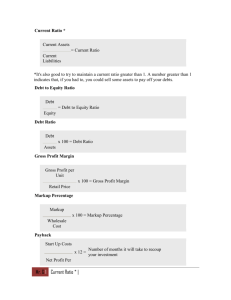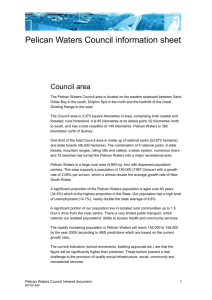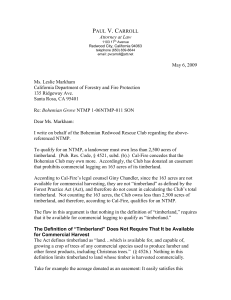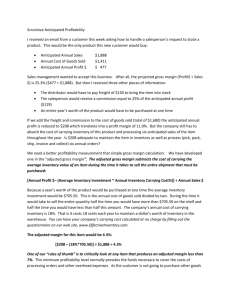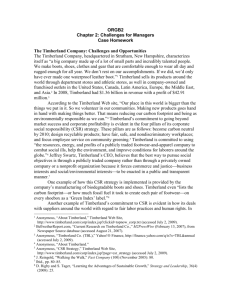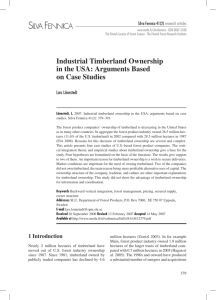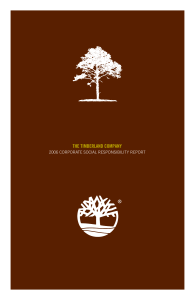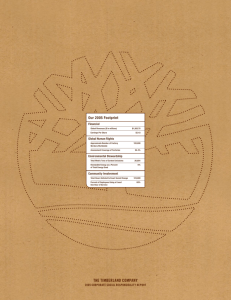chapter3 case and problems
advertisement
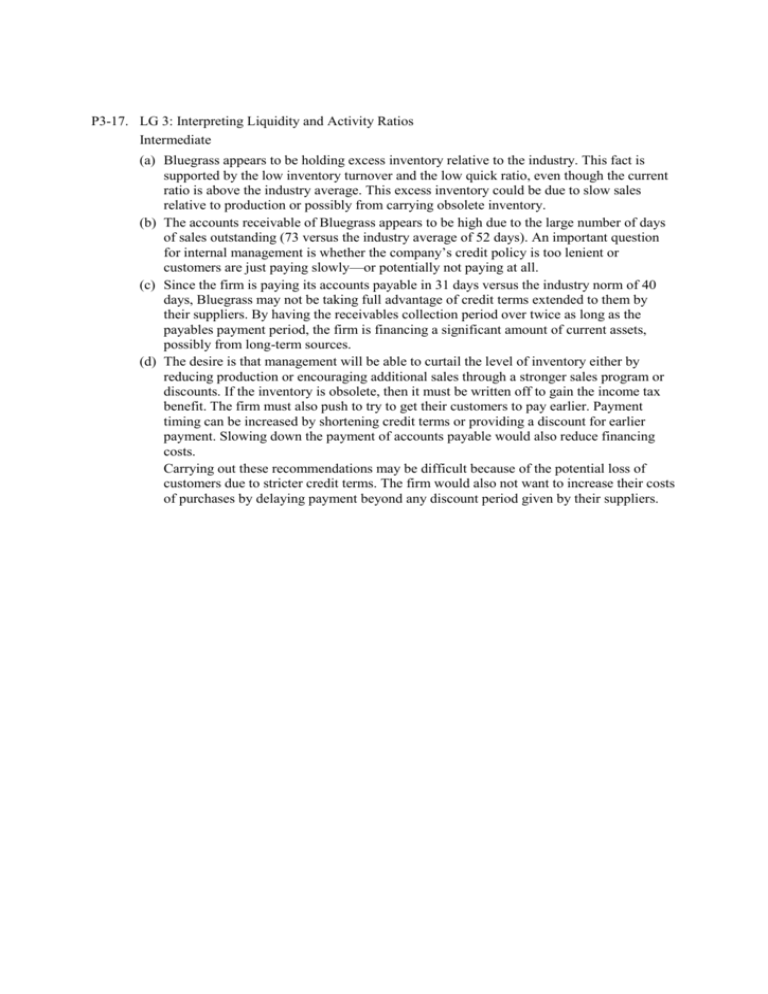
P3-17. LG 3: Interpreting Liquidity and Activity Ratios Intermediate (a) Bluegrass appears to be holding excess inventory relative to the industry. This fact is supported by the low inventory turnover and the low quick ratio, even though the current ratio is above the industry average. This excess inventory could be due to slow sales relative to production or possibly from carrying obsolete inventory. (b) The accounts receivable of Bluegrass appears to be high due to the large number of days of sales outstanding (73 versus the industry average of 52 days). An important question for internal management is whether the company’s credit policy is too lenient or customers are just paying slowly—or potentially not paying at all. (c) Since the firm is paying its accounts payable in 31 days versus the industry norm of 40 days, Bluegrass may not be taking full advantage of credit terms extended to them by their suppliers. By having the receivables collection period over twice as long as the payables payment period, the firm is financing a significant amount of current assets, possibly from long-term sources. (d) The desire is that management will be able to curtail the level of inventory either by reducing production or encouraging additional sales through a stronger sales program or discounts. If the inventory is obsolete, then it must be written off to gain the income tax benefit. The firm must also push to try to get their customers to pay earlier. Payment timing can be increased by shortening credit terms or providing a discount for earlier payment. Slowing down the payment of accounts payable would also reduce financing costs. Carrying out these recommendations may be difficult because of the potential loss of customers due to stricter credit terms. The firm would also not want to increase their costs of purchases by delaying payment beyond any discount period given by their suppliers. P3-20. LG 4, 5: The Relationship Between Financial leverage and Profitability Challenge total liabilities total assets $1, 000, 000 Debt ratioPelican 0.10 10% $10, 000, 000 $5, 000, 000 Debt ratioTimberland 0.50 50% $10, 000, 000 (a) (1) Debt ratio earning before interest and taxes interest $6,250,000 Times interest earned Pelican 62.5 $100,000 $6,250,000 Times interest earned Timberland 12.5 $500,000 Timberland has a much higher degree of financial leverage than does Pelican. As a result Timberland’s earnings will be more volatile, causing the common stock owners to face greater risk. This additional risk is supported by the significantly lower times interest earned ratio of Timberland. Pelican can face a very large reduction in net income and still be able to cover its interest expense. (2) Times interest earned operating profit sales $6, 250, 000 Operating profit margin Pelican 0.25 25% $25, 000, 000 $6, 250, 000 Operating profit margin Timberland 0.25 25% $25, 000, 000 (b) (1) Operating profit margin Earnings available for common stockholders sales $3, 690, 000 Net profit margin Pelican 0.1476 14.76% $25, 000, 000 $3, 450, 000 Net profit margin Timberland 0.138 13.80% $25, 000, 000 (2) Net profit margin Earnings available for common stockholders total assets $3,690,000 Return on total assetsPelican 0.369 36.9% $10,000,000 $3,450,000 Return on total assetsTimberland 0.345 34.5% $10,000,000 (3) Return on total assets (4) Return on common equity Earnings available for common stockholders Common stock equity $3, 690, 000 0.41 41.0% $9, 000, 000 $3, 450, 000 Return on common equity Timberland 0.69 69.0% $5, 000, 000 Return on common equity Pelican Pelican is more profitable than Timberland, as shown by the higher operating profit margin, net profit margin, and return on assets. However, the return on equity for Timberland is higher than that of Pelican. (c) Even though Pelican is more profitable, Timberland has a higher ROE than Pelican due to the additional financial leverage risk. The lower profits of Timberland are due to the fact that interest expense is deducted from EBIT. Timberland has $500,000 of interest expense to Pelican’s $100,000. Even after the tax shield from the interest tax deduction ($500,000 0.40 $200,000) Timberland’s profits are less than Pelican’s by $240,000. Since Timberland has a higher relative amount of debt, the stockholders’ equity is proportionally reduced resulting in the higher return to equity than that obtained by Pelican. The higher ROE is at the expense of higher levels of financial risk faced by Timberland equity holders. P3-24. LG 6: Integrative–Complete Ratio Analysis Challenge Sterling Company Ratio Analysis Actual 2004 1.40 Actual 2005 1.55 Actual 2006 1.67 Industry Average 2006 1.85 Quick ratio 1.00 0.92 0.88 1.05 TS: Deteriorating CS: Poor Inventory turnover 9.52 9.21 7.89 8.60 TS: Deteriorating CS: Fair Ratio Current ratio Average collection period Average payment period 45.6 days 36.9 days 29.2 days TS: Time-series CS: Cross-sectional TS: Improving CS: Fair TS: Improving 35.5 days CS: Good TS: Unstable CS: Poor 59.3 days 61.6 days 53.0 days 46.4 days Total asset turnover 0.74 0.80 0.83 0.74 TS: Improving CS: Good Debt ratio 0.20 0.20 0.35 0.30 TS: Increasing CS: Fair 8.2 7.3 6.5 8.0 Times interest earned Fixed payment coverage ratio Gross profit margin 4.5 4.2 2.7 4.2 0.30 0.27 0.25 0.25 TS: Deteriorating CS: Poor TS: Deteriorating CS: Poor TS: Deteriorating CS: Good Operating profit margin 0.12 0.12 0.13 0.10 Net profit margin 0.067 0.067 0.066 0.058 Return on total assets (ROA) Return on common Equity (ROE) Earnings per share (EPS) Price/earnings (P/E) Market/book ratio (M/B) 0.049 0.066 $1.75 12.0 1.20 0.054 0.073 $2.20 10.5 1.05 0.055 0.085 $3.05 9.0 1.16 TS: CS: Improving Good TS: CS: Stable Good 0.043 TS: CS: Improving Good 0.072 TS: CS: Improving Good $1.50 TS: CS: Improving Good 11.2 TS: CS: Deteriorating Poor 1.10 TS: CS: Deteriorating Good Liquidity: Sterling Company’s overall liquidity as reflected by the current ratio, net working capital, and acid-test ratio appears to have remained relatively stable but is below the industry average. Activity: The activity of accounts receivable has improved, but inventory turnover has deteriorated and is currently below the industry average. The firm’s average payment period appears to have improved from 2004, although the firm is still paying more slowly than the average company. Debt: The firm’s debt ratios have increased from 2004 and are very close to the industry averages, indicating currently acceptable values but an undesirable trend. The firm’s fixed payment coverage has declined and is below the industry average figure, indicating a deterioration in servicing ability. Profitability: The firm’s gross profit margin, while in line with the industry average, has declined, probably due to higher cost of goods sold. The operating and net profit margins have been stable and are also in the range of industry averages. Both the return on total assets and return on equity appear to have improved slightly and are better than the industry averages. Earnings per share made a significant increase in 2005 and 2006. The P/E ratio indicates a decreasing degree of investor confidence in the firm’s future earnings potential, perhaps due to the increased debt load and higher servicing requirements. Market: The firm’s price to earnings ratio was good in 2004 but has fallen significantly over 2005 and 2006. The ratio is well below industry average. The market to book ratio initially showed signs of weakness in 2005 but recovered some strength in 2006. The markets interpretation of Sterling’s earning ability indicates a lot of uncertainty. The fluctuation in the M/B ratio also shows signs of uncertainty. In summary, the firm needs to attend to inventory and accounts payable and should not incur added debts until its leverage and fixed-charge coverage ratios are improved. Other than these indicators, the firm appears to be doing wellespecially in generating return on sales. The market seems to have some lack of confidence in the stability of Sterrling’s future.

